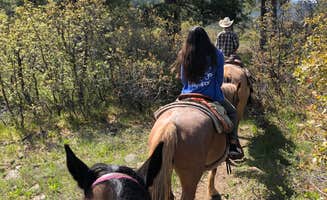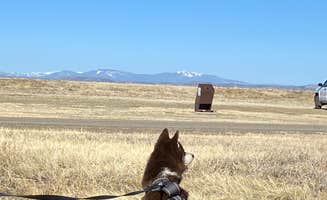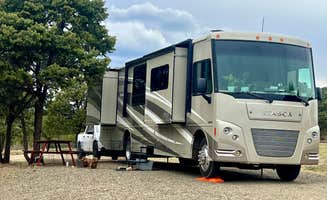Lake 13-Maxwell National Wildlife Refuge sits at an elevation of approximately 5,900 feet in northeastern New Mexico, providing a primitive camping experience in a high desert environment. The area experiences significant seasonal temperature variations with hot summers reaching 90°F and freezing winter nights. Gravel access roads can become challenging after rainfall, particularly for larger vehicles.
What to do
Wildlife viewing opportunities: Lake 13 provides excellent wildlife observation, particularly for bird enthusiasts. "Very secluded... there are reports of bears in the area (wildlife refuge). The view is breathtaking, the sounds of nature are all around you," notes Bobby A. from Lake 13-Maxwell National Wildlife Refuge. Another camper mentions, "Lots of birds, a couple of deer, lots of coyotes off in the distance."
Stargazing sessions: The dark skies in this region make for exceptional stargazing experiences. "The Milky Way was to die for," reports Sheridan L. about the night sky at Maxwell Wildlife Refuge. A visitor to Bell Point Campground also highlighted the "beautiful sunsets" visible from campsites overlooking the lake.
Fishing opportunities: Several lakes in the area offer fishing for various species. At North Campground, one camper noted it was a "Very clean campground with many spots to camp overlooking the lake," making it convenient to fish directly from your campsite. Springer Lake is "stocked regularly with rainbows, and bullheads are also taken" according to Regina Lora G.
What campers like
Open spaces and solitude: The dispersed camping areas provide ample room even during busier periods. "We arrived and there was a schoolie and a van. Later that evening a class A pulled in next to us but there was plenty of room," mentions Madeline S. about Lake 13-Maxwell National Wildlife Refuge.
Clean facilities: Despite being primitive, the facilities are generally well maintained. At North Campground, campers appreciate the "Good bathrooms" and overall cleanliness of the facilities. The Capulin RV Park received similar praise: "The couple running the park are very nice. Bathrooms are clean."
Pet-friendly environment: Most campgrounds in the region welcome dogs with standard leash requirements. The Whittington Center Campground offers pet-friendly accommodations across various site types. As one reviewer noted about Conchas Lake State Park, "Camp was quiet enough. Deer cover the campground... Kids loved it and so did dogs."
What you should know
Water availability: Most primitive sites lack potable water. "No potable water, no electric, no sewer. True boondocking site," explains a reviewer at Lake 13. Come prepared with sufficient water supplies for your stay, especially during summer months when temperatures climb.
Weather considerations: The region experiences dramatic weather patterns that can affect camping conditions. "North eastern and north central New Mexico have had days of heavy rain and flooding alerts... The 2-3 miles of dirt washboard road was not a problem when dry, but would be a problem after rain," warns Susan N. about Lake 13-Maxwell National Wildlife Refuge.
Cell service variability: Connectivity varies significantly between campgrounds. While some areas have surprisingly good coverage, others are completely off-grid. "AT&T had two bars of LTE service. AT&T Speedtest: 36.6 Mbps down, 7.5 Mbps up. Free WiFi is available," reported David B. about Capulin RV Park, while at North Campground, campers noted "no cell reception most of way from highway."
Tips for camping with families
Animal encounters: The region offers abundant wildlife viewing opportunities that children might enjoy. "We saw a roadrunner near our site which was really neat," mentions Nikki P. about their stay at Conchas Lake State Park, while others report deer regularly visiting campgrounds.
Junior ranger activities: Some of the national monuments and wildlife refuges offer educational programs. "The rangers gave the kiddos a coloring book and badge when we got here," shared Natalie F. about their family experience at Conchas Lake, making it one of the more dog-friendly campgrounds near Mills with structured activities for children.
Safety considerations: Be aware of your surroundings, particularly regarding wildlife. When visiting Springer Lake, one camper decided against staying because "there is a correctional facility 2 miles down the road," highlighting the importance of researching the immediate surroundings of any campsite when traveling with family.
Tips from RVers
Access road conditions: Several campgrounds have gravel or dirt access roads that can be challenging for larger rigs. "Roads are gravel and well maintained," notes a camper about Lake 13-Maxwell National Wildlife Refuge, but conditions can change quickly with weather. "We have a 43' fifth wheel and made it there with no problem so definitely big rig friendly," confirms another camper.
Hookup availability: While primitive camping is common, several campgrounds offer partial or full hookups. "Electric was appreciated, but water was unavailable due to repairs, the dump station and showers were closed," reported Nikki P. about Bell Point campground, highlighting the importance of checking current utility status.
Site spacing concerns: RV site sizes and layouts vary significantly between campgrounds. At Capulin RV Park, one reviewer noted, "The sites are very close together," while at the NRA Whittington Center Campground, a camper raved about the generous spacing: "The spaces are huge! We are on an end and I think ours is about a quarter acre in size!"





